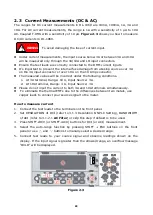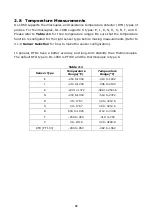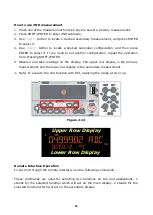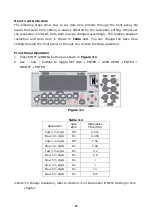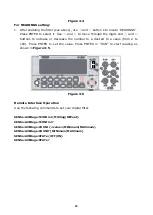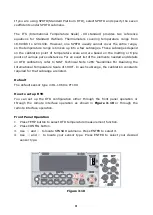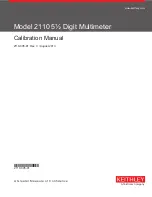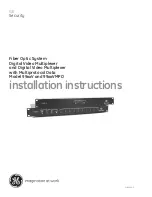
37
[SENSe:]FUNCtion
“
<function>
”
For example:
FUNCtion[1/2] “VOLTage:DC”
FUNCtion[1/2]
“
VOLTage:AC
”
FUNCtion[1/2]
”
CURRent:DC
”
FUNCtion[1/2]
“CURRent:AC”
FUNCtion[1/2]
“FREQunecy”
FUNCtion[1/2]
“PERiod”
FUNCtion[1/2]
“FREQunecy:CURR”
FUNCtion[1/2]
“PERiod:CURR”
FUNCtion[1/2] “RESistance”
FUNCtion[1/2]
“FRESistance”
FUNCtion[1/2] “CAPacitance”
FUN
Ction[1/2] “TEMPerature”
FUNCtion[1/2]
“TCOuple”
FUNCtion[1/2]
“NONE”
FUNCtion[1/2]?
When enabling the 2nd function, you can still set the range and NPLC individually. The
setting procedures are as usual.
To set the range and NPLC through the remote interface, use the following commands:
[SENSe:]<function>:RANGe {<range> | MINimum | MAXimum}
[SENSe:]<function>:RANGe:AUTO {OFF | ON}
[SENSe:]<function>:NPLCycles {0.001|0.006|0.02|0.06|0.2|0.6|1|2|10|100|MIN|MAX}
To read and fetch values from the DMM, use the following commands:
READ[1|2]?
FETCh[1|2]?
For example:
FUNC2 “VOLT:DC”
(Set secondary function to DCV)
READ2?
(
Take secondary reading
)
READ?
(
Take readings;
SD.DDDDDDDDESDD, SD.DDDDDDDDESDD <nl>
)
The following error codes might occur when corresponding function or range is not
enabled or mismatch.
⚫
-243
Second function invalid
It means Secondary function is not enabled
⚫
223 2nd function mismatch
It means function/2nd func mismatch.
⚫
225 Function/range mismatch
It means function/range mismatch.


